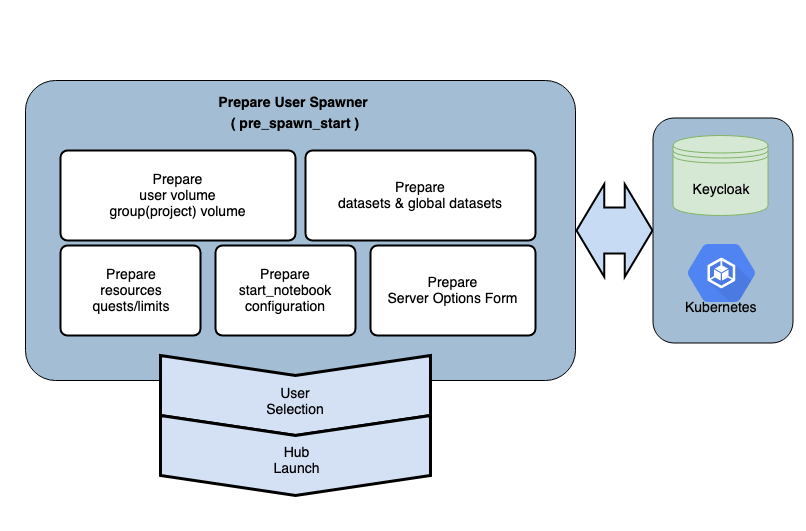Integration with JupyterHub
This document describes the integration of PrimeHub and JupyterHub. The whole magic happens in jupyterhub_profiles.py, under the hood, it collects data from Keycloak(roles-related) and CRDs (Instance Type, Image and Dataset) from K8S in the procedures and it prepares a spawner (with an rendered options page) for a user according to what data/logic are prepared. Then it launches a hub based on the user selection (Group, Instance Type and Image).
The concept diagram

Imported
There are serveral imported modules which are worth attention are used for api interaction or interfaces.
from kubespawner.clients import shared_client
from kubespawner import KubeSpawner
import kubernetes.client
from z2jh import get_config
from oauthenticator.generic import GenericOAuthenticator
from jupyterhub.handlers import LogoutHandler
from kubespawner.objects import make_pvc
from kubernetes.client.models import V1LabelSelector
from kubernetes.client.rest import ApiException
from kubespawner.traitlets import Callable
Classes and Methods
There are three main classes, OIDCLogoutHandler, OIDCAuthenticator and PrimeHubSpawner in jupyterhub_profiles.py listed in the table below.
| Class | Description |
|---|---|
| OIDCLogoutHandler | The implementation of LogoutHandler which redirect to logout_url of Keycloak. |
| OIDCAuthenticator | The implementation of GenericOAuthenticator of OpenID way. |
| PrimeHubSpawner | The implementation of Kubespawner. The core of PrimeHub spawner. |
OIDCLogoutHandler
| Method | Description |
|---|---|
| get | redirect to keycloak logout url and redirect back with kc=true parameters, then proceed with the original logout method. |
OIDCAuthenticator
Here we list several main methods which are worth attention in the table below. Growing methods are expected with the progressive development.
| Method | Description |
|---|---|
| attach_project_pvc | To append/create a PVC according to the project, group and size. |
| authenticate | To authenticate a user and return it if validated. |
| get_custom_resources | To get CRDs from K8S. |
| is_admin | To learn if a user is administrator or not. |
| mount_dataset | To determine where and what to mount datasets by a combination of logics such as type, global, launch_group, annotations and so on. |
| user_volume_capacity | To get a user volume capacity by the business logic. |
| get_datasets_in_launch_group | To get datasets of the launching group. |
| get_global_datasets | To get global datasets. |
| pre_spawn_start | The core of PrimeHubSpawner that it determines/collect what a spawner of a user should be capable of according to a series of logics and configurations in Keycloak and CRDs of K8S. |
PrimeHubSpawner
Here we list several main methods which are worth attention in the table below. Growing methods are expected with progressive development.
| Method | Description |
|---|---|
| _start | To launch a hub while checking the sufficiency of resources, otherwise to stop launching immediately. |
| apply_kubespawner_override | To apply/override values of KubeSpawner. |
| check_event | To check messages of a event to see if resource is sufficient. |
| get_request_resources | To get requests of resources. |
| image_to_override | To override values of an image with a url and a pull_secret if any. |
| instance_type_to_override | To apply/override values of an instance type, such as requests/limits of resources, node_selector and tolerations. |
| options_from_form | To get values of options for rendering a Server Options form. |
| render_html | To render a html according to a template and values. |
References
| Reference |
|---|
| Kubespawner |
| Zero to JupyterHub with Kubernetes |
| Keycloak Admin REST API |